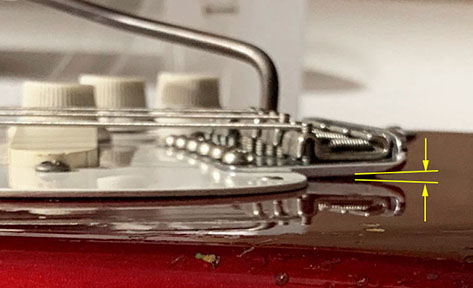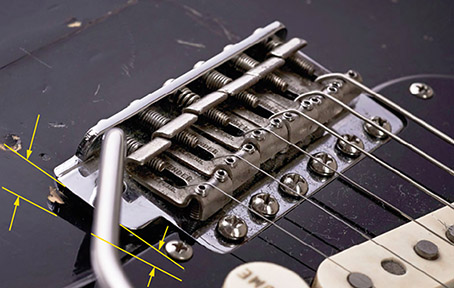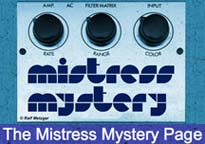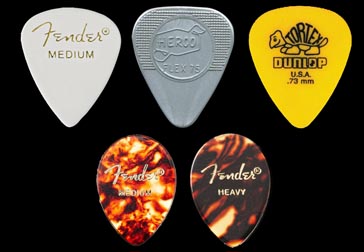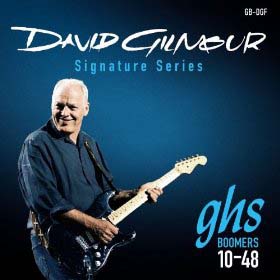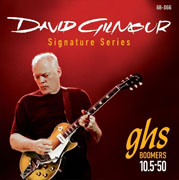NOTE: This website is frequently updated. Last update March 2023.
It is almost cliche to say this, but a majority of what is percieved as Gilmour's tone and sound really does come from his fingers and playing. Gear selection helps, but much of the tone comes from the way the strings are picked, fretted, and how the tremolo is applied. Note choice is obviously a key to what makes a guitarist's style unique and identifiable, but you really need to invest the time to learn the picking, tremolo techniques, and phrasing to repicate the overall sound. David rarely lets a note just sit still. It is always moving or changing. Much of what people think is the gear making the tone sound good is simply the fingers making the gear sound good. For example, Big Muff's tend to be a bit harsh and fizzy, but when you add some fluidity and subtle harmonics to your playing it makes the Muff sound very un-Muff like, bringing something out of the it that you can't get with any other fuzz pedal. Add a sweet chorus or flange, some long delay, and you are in tonal heaven.
I spent a lot of time trying to be Eric Clapton, Jimi Hendrix, Pete Seeger, Leadbelly…all sorts of other people on the guitar…and there was a moment when I actually liked something I played myself and started realizing that what I saw as my deficiencies actually could be turned into my qualities. - Gilmour interview by John Edginton in 2001
I think one thing about the fingers and the brain that I have been given is that the fingers make a distinctive sound. The fingers aren't very fast, but I think I am instantly recognizable. I can hear myself and just know that's me. And other people do, too. The way I play melodies is connected to things like Hank Marvin and the Shadows - that style of guitar playing where people can recognize a melody with some beef to it - Gilmour from Guitarist 2006
It's very hard to advise people, but in general I would say listen to as many different types of music as you can. And don't worry. Let everything come out of you in whatever way feels right, rather than wasting a lot of time and energy in trying to be someone else. That's what I'm trying to do myself. - Gilmour from Guitar World 1988
Although this website is dedicated to a study of David Gilmour's tone and gear, I suggest you use it as a jumping point for your own tone and style. You should also study other artists you like and learn their techniques as well, then mix them together to create you own unique signature sound and style. Any style you study and play frequently will eventually filter through your brain and come out in your own playing in some form. I will not go into the blues scales David uses or the gets into the music theory specifics of David's work, but below are are a few pointers about the style and the techniques of his playing.
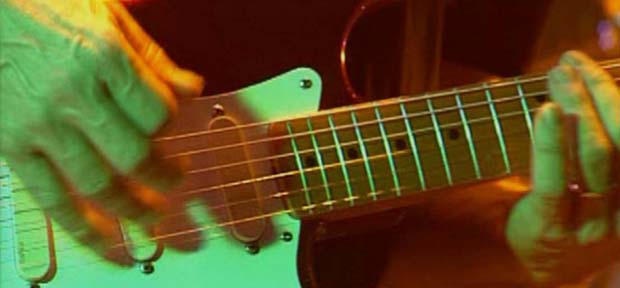
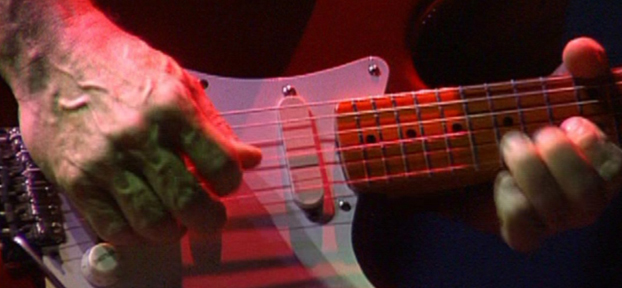
GILMOUR PLAYING STYLE
It obviouly sounds better when you use the right gear, guitar, pickups, amp, and settings to replicaet Gilmour's guitar tones - but you still won't have that Gilmour sound and tone unless you take the time to learn his style of playing. As said above, most of what we hear as "tone" is from the playing. Using the right gear just brings out the colors and accents of the playing more.
I remember when I first began learning Gilmour songs around the time of his About Face (1984) album. I bought basically the same pedals David had at the time and a Strat style guitar, but I was frustrated that I could not get anything close to his sound. I learned the solos note for note, but I was just pressing frets, not actually playing in his style. Years later when I actually took the time to learn the subtleties of his style - finger and whammy tremolo, subtle picking harmonics, string bends, and phrasing - that sound came together rather easily. The correct gear was just tonal icing on top of that. That's why David says he can go into any music store and with just some basic gear he can still sound like himself - the gear does not make him sound like him. He does.
I love Dave’s guitar solos on DSOTM and on WYWH and on Animals and on The Wall and on The Final Cut. In my, albeit biased view, Dave’s solos on those albums constitute a collection of some of the very best guitar solos in the history of rock and roll. - Roger Waters on Twitter in 2023
FINGER AND WHAMMY BAR TREMOLO - Much of the beauty and soul of David's playing comes from his signature use of tremolo. Playing standard, one-speed tremolo on every note like 90% of the players out there do does not have even half the feeling that David can get out of one note with his style. He does not just generically shake a note when he adds tremolo. Sometimes he uses finger tremolo on the fret, other times he uses the whammy bar tremolo, and sometimes he goes from one right into the other on the same note.
David's use of finger tremolo is exceptional, but he only occasionally used the whammy bar tremolo in his early days with Pink Floyd. Like many Strat players, the bar was usually used for note dives or rapid tremolo effects, like in the solo in the funky part of Echoes from Live at Pompeii. During the recording sessions for Pink Floyd's The Wall album in 1978-79, his whole whammy bar style changed. He developed and refined a new technique that became a signature of his playing style from that point onward. He used a floating bridge so he could pitch notes up or down, and his whammy bar tremolo became just as smooth as his finger tremolo, but distinctly different. If you watch the live CBS promo videos for David's first solo album in 1978 and compare those to the live 1980 Pink Floyd vidoes from The Wall tour you can see how dramatically different this new approach to tremolo was.
David's whammy bar tremolo pitch was much deeper than his finger tremolo and he often kept the bar in his palm for whole solos. That technique was something David learned from watching one of his guitar heroes, Hank Marvin of the Shadows. Many of David's tremolo technniques can be traced back to similar things that Hank did, but David's version was uniquely different. This new style added much more feeling and emotion to his solos. The effect can be heard all over The Wall, in songs like Mother, What Shall We Do Now, Hey You, and the first Comfortably Numb solo in particular. David also used it to superb effect in his solos for Roger Waters The Final Cut album. He sometimes uses wide, deep, and slow tremolo for a more dramatic and emotional playing, like in the first Comfortably Numb solo. Other times he uses shorter, faster tremolo for a more intense, harder-edged feel, like in the second Comfortably Numb solo. He sometimes lets a note sustain before slowly starting the tremolo, other times starts right into the tremolo. He also sometimes goes from slow tremolo on one note to fast on the next, which adds another dynamic to his playing.
Like vibrato, for instance. I like a kind of refined version, which I do either with a finger or with a wang bar ... sometimes both at the same time. - David Gilmour, Guitar World, July 1988
As most guitarists know, David uses a lot of finger vibrato as well as the whammy bar, often at the same time. On the first solo of ‘Comfortably Numb’ he was exaggerating the effect quite dramatically. I asked if he thought it was too much and he replied, “No, I want it to sound drunk!” And there it was. - James Guthrie, producer/engineer on The Wall - Brain Damage 2013 interview
The tempo of the tremolo is very important. It really should be as close in time with the song tempo as possible. Most people can learn fast tremolo easily, but it takes some practice to learn how to accurately do slow tremolo and stay in time and pitch, especially with the tremolo bar on a Strat. Using a floating tremolo, the pitch from sharp to flat should be as smooth as possible, without going too sharp or too flat. Practice recording yourself playing a single note, intentionally trying to bend your tremolo up above the note pitch, sharp. Then do the same intentionally trying to go below the note pitch, flat. Then record yourself trying to do it right in the middle, not too sharp or too flat, and listen back to all three. If your correct attempt sounds more like the sharp or flat recordings, that indicates what you need to work on more. This was probably the most important part of applying Gilmour style temolo that I learned.
The bridge plates on Gilmour's Strats are resting on the body on the bridge screw side and raised on the saddle screw side.
The 4th edition of the Black Strat book specifies the bridge floats 1.5mm off the body.
One part of David's whammy bar tremolo that took me a long time to figure out was if he was just pitching notes up, or pitching up and down evenly between flat and sharp. Non-floating bridges, like I believe David used in his early Pink Floyd days, can only pitch down. The bridges on David's Strats from around 1976 and later are floating just slightly off the body, so he can pitch up or down. What I noticed when trying to replicate certain solos is that he sometimes pitches up and down evenly, other times his tremolo is pitched slightly sharp, other times slightly flat. It really depends on the note in the solo.
When using the whammy bar it helps to have your bar cut short so you can hold the tip in your plam when playing, as David does. Some information on how to do this can be found here. It is not necessary, but it does help playing the way David does if you can hold it in your palm so it does not interfere with picking the strings.
NOTE BENDS - Practice those bends! The Another Brick in the Wall II solo is a great one to study and master. David can bend and hold notes in exact pitch fluidly, and his bends are precise and in time with the song. He often bends up a whole or half step, holds, then bends up or down another step, then back to the original bend position before dropping the bend back to the original fretted note - sometimes adding his subtle tremolo to a few areas of these notes in mid bend! David also mixes slow bends with fast bends, but all in very precise time with the song tempo. It is rather easy once you get it down, and adds some great phrasing to your playing, but practice, practice, practice. Being slightly off key or out of time in a bend can ruin the effect.
PINCH SQUEALS AND PINCH HARMONICS - This is one of the most important keys to David's style of playing, and the one aspect of his sound that people most often confuse as something the gear David is using is doing. If you listen you will occasionally hear him add a pinch harmonic squeal to certain notes - such as the very first note in the Comfortably Numb outro solo, or many times in the Young Lust solo. David's sound very unique and subtle compared to the harsh, trebly pinch harmonics of some other players. Those pinch squeals are important to learn, and not very difficult for most players to master.
More important are the other harmonics that David applies. If you listen to his playing closely you will find that there are other subtle pick+thumb harmonics in many of the other notes in his solos, not just those pinch squeals. Many people mistake this as something the effects he uses are adding to the sound. Effects like chorus and the Big Muff can accent those harmonics, but David's fingers are where that sound is coming from, or more specifically, his thumb. When using a guitar pick he lets part of his thumb flesh brush across the string as he picks to add those subtle harmonic tonal variations to the notes. This harmonic phrasing and coloring is all over David's playing - to the extreme on just about every note in the Young Lust solo, and more of a subtle harmonic coloring in the Coming Back to Life or the On an Island solos. It is very evident in David's playing for Pink Floyd's Division Bell tour, heard on Pulse, and David's On an Island tour, featured in the Live in Gdansk film. Below are some examples of harmonic picking, comparing phrases with and without thumb+pick harmonics. I have exaggerated the effect to make the differences more apparent.
![]() Harmonic Picking Samples - each phrase is played first with the pick only, then with pick+thumb to add harmonics
Harmonic Picking Samples - each phrase is played first with the pick only, then with pick+thumb to add harmonics
To learn this method of harmonic picking, first practice and master the less subtle pinch squeal effect. That is achieved by brushing the thumb across the string with the pick to get the harmonic squeal. We call it 'pinch harmonics' because you are pinching the pick and your thumb together as you pick hard, but it's really caused by both your thumb and pick touch the strings when you pick, so both touch the string at nearly the same time. When you have mastered being able to do that any time you want, then practice being more subtle with the thumb so you hear some of the harmonics, but not the harsher squeal. It often does not require hard picking to do this, and you will find that using more of the thumb than the pick creates one type of harmonic, and more of the pick than thumb another type. Once you have mastered that, then practice going back and forth between the subtler pinch harmonics and the harder pinch squeals until you can do it fluently.
You can do this type of picking with nearly any guitar pick, but it is much easier to do with smaller teardrop shaped picks than larger triangular shaped picks. Fender teadrop picks, size 354, are the best pick to use for this in my opinion. That is also what David uses.
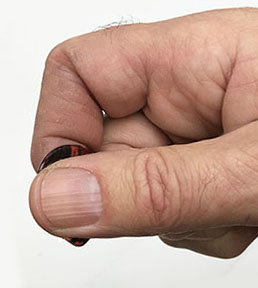
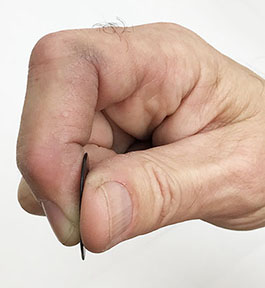
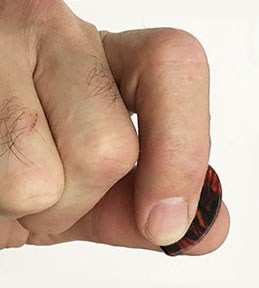
This is how I hold a teardrop pick to produce harmonic tones when picking, keeping my thumb close to the tip of the pick to allow both to contact the string
FINGER PICKING - David has a very unique finger-picking style that he often uses. For examples, listen to Cluster One from the Division Bell, the intro to the live Strat Pack version of Coming Back to Life, or 5 A.M. from Rattle That Lock. That is all finger-picking on electric guitars. Rather than using specific fingers on specific strings, David mostly just uses his index finger as if it were a pick, with the occasional use of his thumb. He gets a wide variety of sounds just from the way he picks the string. Picking soft or hard, sliding the finger across the string, pulling off hard so the string "pops" like a compressive attack - these are all techniques that David uses to add color to the notes. He even gets subtle harmonics with his finger-picking. I learned how to finger pick traditionally, but I never got my playing to sound as expressive as David's. I thought it was something to do with the type of compressor David was using, or some other gear mystery. When I actually watched and studied how he finger picked, then re-learned how to pick just using my index finger, it all clicked into place. David often uses a compressor when finger picking on an electric, but most of the compression effects are really just from the way he picks.
Below are some examples of this finger picking style. Each time a phrase is repeated I change the way I am picking it to illustrate the wide variety of possible sounds. You can not only change the way the pick attack sounds, you can change the tone of the guitar simply by changing the way you pick.
"It think it's just pretty much him. He is obviously using a couple of effects, like a Big Muff and a delay, but it really is just his fingers, his vibrato, his choice of notes and how he sets his effects. I find it extraordinary when people think they can copy his sound by duplicating his gear. In reality, no matter how well you duplicate the equipment, you will never be able to duplicate the personality" - Gilmour's backline and gear tech, Phil Taylor
MORE NOTES VERSUS LESS - You will notice that David is not a very fast player, but at times he can sound more intense that someone playing a barrage of notes at light speed. That is because David adds all of these elements described above to his solos. Each note is always moving and doing something, adding to the complex feel some of his solos have. Just pressing frets abd picking the individual notes of those solos is not very complicated. When you add the tremolo, harmonics, bends, and other elements of David's playing, and how he plays over the music, it becomes something very complex and moving.
VOLUME SWELLS - This has nothing to do with the way you pick or play the guitar, but it is another part of David's playing that adds color to a solo. You kill the volume using a volume pedal, or volume knob on your guitar, pick a note, then raise the volume back up so the note fades in. This is also called a volume swell, and David uses a volume pedal for this effect, typically when he plays slide guitar. He often does this when bending or sliding a note up, and he is careful not to over use the effect. Listen to the slide guitar on Breathe and The Great Gig In The Sky from Dark Side of the Moon, or Beauty and A Boat Lies Waiting from Rattle That Lock for examples. Cluster One from the Division Bell and Evrika from The Endless River Deluxe Edition are examples of this technique with a regular guitar.
PICKS - The size, shape, and hardness of the guitar pick will affect how you play and your sound. David has used various shapes and sizes of picks throughout his career. He used Plain Herco heavy picks in the 1970s, but around the time of The Wall in 1980 he changed to small Fender teadrop picks, size 354, which are still his preferred electic guitar picks. He used Dunlop Herco Flex 75 1.01mm picks for his 2006 and 2015-16 tours, D'Andrea custom white 354 picks, as well as Fender 354 and Fender 351 style tear drop picks. David's pick attack on the strings can be very subtle or very hard, depending on the accent being applied to the note. When playing live, he is very hard on his picks. The edges look like they have been sawed into!
Three standard sized pics (top) compared to Fender 354 tear drop shaped pics (bottom)
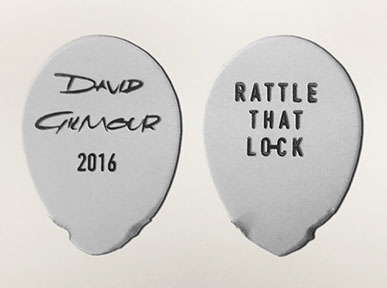
A few of David's used D'Andrea 354 picks from his 2016 tour showing the wear from his hard playing on fresh heavy gauge strings every show
As a general rule, larger picks work best for the early Pink Floyd material, and smaller picks work best for his later material and for applying harmonic tones. You can let the flesh of the thumb touch the string while picking using most picks, but tear dropped shaped picks, like the Fender 354 pick, are much easier to use for this than larger triangular shaped pics. The 354 pick is almost the same length as a standard pick, but not as wide and with a sharper point. They are sometimes difficult to find, but I have found the 354 "heavy" picks allow me to be the most expressive versus any other type pick.
STRINGS and STRING GAUGES FOR STRATS, TELE, AND LES PAUL - David Gilmour typically uses light gauge strings on he electric guitars. Over the years he has used various guitar string gauges on his Strats and various strings brands like Gibson, Rickenbacker, Ernie Ball, and GHS. For electrics he usually uses light gauge strings in the studio. When performing live he plays heavy handed and is harder on the strings so he uses a heavier gauge.
In the early 1970s David was using Gibson Sonomatic light gauge electric guitar strings on his Stratocasters. These were nickel wrapped, round wound strings.
Gibson Sonomatic Light Gauge - .011, .012, .019w, .028, .044, .050
Some time after that David used Ernie Ball light gauge strings, which I assume were the Regular Slinky nickel wound stings, not the Super Slinkys.
Ernie Ball Regular Slinkys .010, .013, .017, .026, .036, .046
In the late 1970s he was using a custom gauge set of Gibson Sonomatic on his Strats in the studio, and a set of different gauges when playing live.
late 1970s Strat gauges used in the studio - .010, .012, .016, .025, .034, .044
late 1970s Strat gauges used on stage - .010, .012, .016, .028, .038, .050
The Black Strat book contradicts this info, but I am going with what David actually said he used in a 1979 interview.
When recording The Wall in 1979 David changed to GHS Boomer strings and has continued to use them on his electrics. At the time I wrote this article David was still using GHS Boomers in non standard gauge sets for his Strats. GHS sold this exact set (as of 2008) as GB-DGF David Gilmour Signature Blue Set Electric Guitar Strings.
Strat string gauges from 1979 to now - .010, .012, .016, .028, .038, .048
David used a heavier gauge set on his Les Pauls. GHS sold this exact set (as of 2008) as GHS GB-DGG David Gilmour Signature Red Set Electric Guitar Strings.
Les Paul string gauges - .0105, .013, .017, .030, .040, and .050
Years ago I used to use regular light Gibson Sonomatics. I really liked them but they were a bit too heavy….well, I didn't use the top end…Let's see, and then I went to Ernie Balls because I could get them a bit lighter. And recently, I don't know quite when, Gibson started bringing out those Sonomatics in custom gauges, and I'm using those at the moment mostly...On my regular electric guitar at the moment (late 1978) I'm using the Gibsons (Sonomatics) again, which are 44, 34, 25, 16, 12, 10 gauges. It's pretty light for me. On stage actually with the Floyd I use heavier gauges, again on the bottom three I still use 10, 12, and 16 on the lighter strings, but I use 28, 38, 50 on the heavy bottom strings. That's for when I'm working on stage. I'm a bit heavy handed you know. - David Gilmour from a Steve Rosen interview for Guitar World conducted in late 1978 or early 1979
I use GHS strings, 10's - David Gilmour from Guitarist magazine June 1986
TELECASTER STRINGS - I do not think David has ever mentioned his Telecaster string gauges, but the Fitch/Mahon Comfortably Numb History of The Wall book lists Tele string gauges from The Wall period.
Telecaster string gauges from 1979 - .010, .012, .016, .024, .036, .044
LAP STEEL SLIDE GUITAR STRINGS - Around 2008 Phil Taylor said David currently used D’Addario EHR360 half round jazz strings on his electric lap steels. These have a semi flat surface on the wound strings which creates a slightly smoother sound with a steel slide than regular round wound strings.
Lap Steel string gauges from 2008 - .013, .017, .026, .036, .046, .056.
Kit’s Secret Guitar, Gear, and Music Page
Guitar stuff, gear stuff, soundclips, videos, Gilmour/Pink Floyd stuff, photos and other goodies.
Copyright Kit Rae.
VISIT MY SWORDS, KNIVES and FANTASY ART WEBSITE www.kitrae.net

